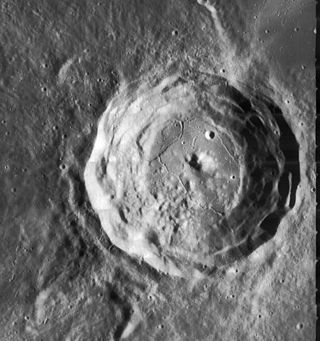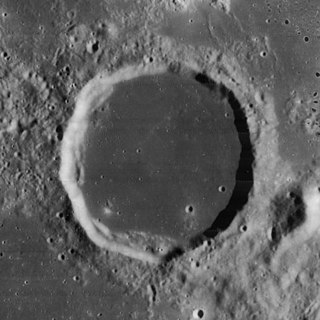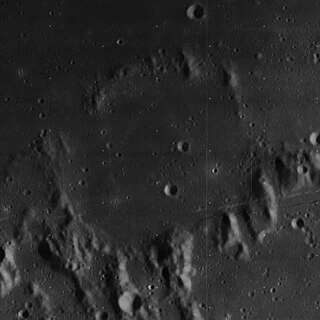
Brayley is a lunar impact crater located in the southwest part of the Mare Imbrium. It was named after British geographer Edward W. Brayley in 1935. It has a circular rim and a low rise in the center. There are no notable craters overlapping the rim or interior. The sinuous rille Rima Brayley passes to the north of Brayley.

Sharp is a lunar impact crater located to the west of the Sinus Iridum bay of the Mare Imbrium, beyond the Montes Jura range. To the southwest is the crater Mairan. Because of its location and foreshortening, Sharp appears elliptical from the earth.

Milichius is a bowl-shaped lunar impact crater that is located in the northern part of the Mare Insularum. To the southeast is the slightly larger Hortensius, a similar formation.

Ariadaeus is a small, bowl-shaped lunar impact crater on the western shores of Mare Tranquillitatis. It lies to the north of the crater Dionysius, and to the west-southwest of Arago. The crater is joined along the northeast rim by the slightly smaller Ariadaeus A, and the two form a double-crater. Its diameter is 10.4 km.

Cardanus is a lunar impact crater that is located in the western part of the Moon, in the western part of the Oceanus Procellarum. Due to its location the crater appears very oval because of foreshortening, and it is viewed almost from the side.

Diophantus is a lunar impact crater that lies in the southwestern part of the Mare Imbrium. It was named after ancient Greek mathematician Diophantus. It forms a pair with the larger crater Delisle to the north. Diophantus has a wide inner wall and a low central rise. To the north of Diophantus is the sinuous rille designated Rima Diophantus, named after the crater. Diophantus C lies near the exterior of the southwest wall.

Flammarion is a lunar impact crater on the south edge of Sinus Medii. Its diameter is 76 km. It is named after the French astronomer Camille Flammarion. It is located between the crater Mösting to the northwest and Herschel to the southeast. The bowl-shaped Mösting A intersects the western rim of Flammarion.

Prinz is the lava-flooded remains of a lunar impact crater on the Oceanus Procellarum. It was named after German-Belgian astronomer Wilhelm Prinz. The formation lies to the southwest of the prominent crater Aristarchus. To the north-northeast is the flooded crater Krieger.

Réaumur is the remains of a lunar impact crater located on the southern edge of Sinus Medii. Its diameter is 51 km. It was named after the 18th century French scientist René de Réaumur. It shares an eroded rim with the similar crater Oppolzer to the northwest. It lies to the northwest of the large walled plain Hipparchus, and east of Flammarion. To the south is Gyldén, and farther to the south-southwest is Ptolemaeus.

Billy is a lunar impact crater that is located at the southern fringes of the Oceanus Procellarum, in the western hemisphere of the Moon. It was named after French mathematician Jacques de Billy. It lies to the southeast of the similar-sized crater Hansteen, and west-southwest of the flooded Letronne.

Calippus is a small lunar impact crater that is located on the eastern edge of the rugged Montes Caucasus mountain range in the northern part of the Moon. It was named after Greek astronomer Callippus of Cyzicus. It lies to the southwest of the crater remnant Alexander, to the northwest of the Mare Serenitatis.

Sömmering is the lava-flooded remains of a lunar impact crater on the eastern edge of the Mare Insularum. It was named after German doctor Samuel Thomas von Sömmerring. To the southeast is the crater Mösting, and north of Sömmering lies a similar flooded crater designated Schröter. A rille designated Rima Schröter runs from the southeast of Schröter towards the east of Sömmering's outer rim.

Oppolzer is the remnant of a lunar impact crater that is located on the southern edge of Sinus Medii, along the meridian of the Moon. Its diameter is 41 km. It was named after the Austrian astronomer Theodor von Oppolzer. It is located within one crater diameter of the origin of the selenographic coordinate system at 0° N, 0° W. Attached to the surviving remnants of the southeast rim is the crater Réaumur. To the west-southwest is the lava-flooded walled plain Flammarion.

Conon is a small but prominent lunar impact crater that lies in the eastern foothills of the Montes Apenninus mountain range. The crater is named for the Greek astronomer Conon of Samos. Just to the west of Conon is the long mountainous ridge Mons Bradley. The nearest craters possessing an eponym are Galen, about 70 kilometres (43 mi) to the east, and Aratus, about the same distance to the northeast.

Yangelʹ is a small lunar impact crater that is located in the irregular terrain to the north of the Mare Vaporum. Its diameter is 8 km. It was named after Soviet rocketry scientist Mikhail Kuzmich Yangelʹ in 1973. This crater was formerly designated Manilius F.

Darwin is a lunar impact crater of the type categorised as a walled plain. It lies in the southeastern part of the Moon, and is sufficiently close to the limb to appear significantly foreshortened when viewed from the Earth. Attached to its southern rim is Lamarck. To the northeast is the dark-floored crater Crüger.

G. Bond is a small lunar impact crater to the south of the Lacus Somniorum, a small lunar mare in the northeast part of the Moon's near side. It was named after the American astronomer George Phillips Bond. It lies to the east of the larger crater Posidonius, and to the south of the flooded crater remnant Hall. The crater is situated in a rugged section of terrain to the northwest of the Montes Taurus mountain region.

Weiss is a lunar impact crater along the southern edge of the Mare Nubium. It was named after Austrian astronomer Edmund Weiss. Nearly attached to the southwest rim is the crater Cichus, and Pitatus lies just over one crater diameter to the east-northeast. To the east-southeast lies the eroded Wurzelbauer.

Mons Hadley is a massif in the northern portion of the Montes Apenninus, a range in the northern hemisphere of the Moon. It has a height of 4.5 km (2.8 mi) 14,764 ft (4,500 m) above the adjacent plain and a maximum diameter of 25 km at the base.

Mons Bradley is a lunar mountain massif in the Montes Apenninus range, along the eastern edge of the Mare Imbrium. It is located to the west of the crater Conon. To the west of this peak is the Rima Bradley rille.






















